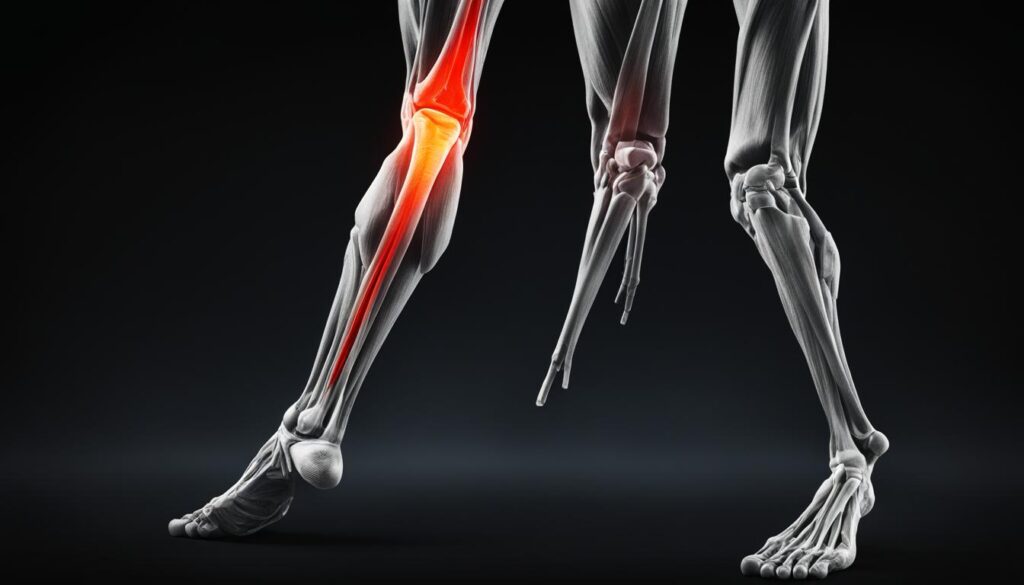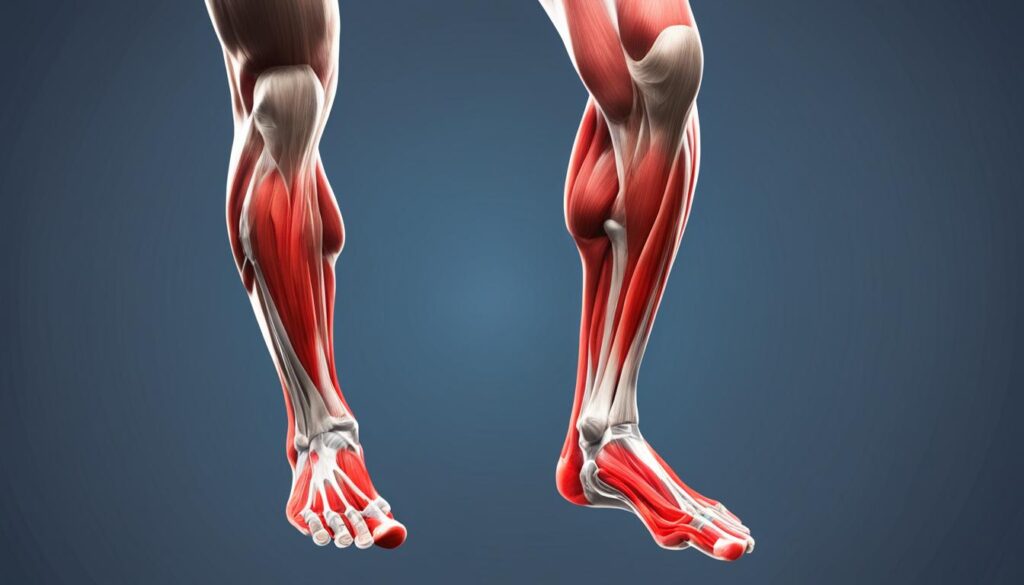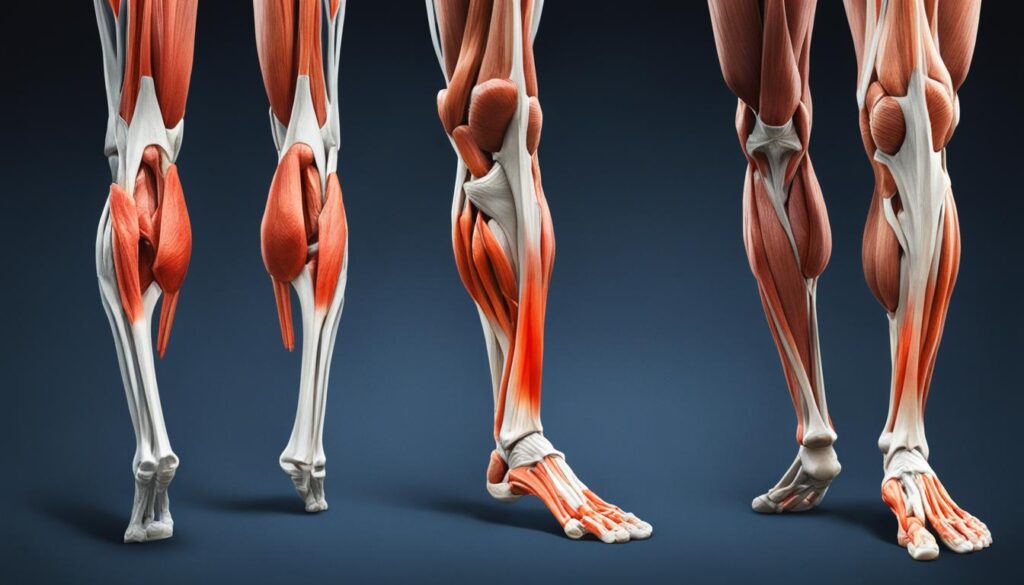If you’ve ever experienced muscle pain or discomfort in your legs, you may have wondered whether it was a leg cramp or a muscle strain. While both conditions can cause similar symptoms, it is important to differentiate between them in order to receive the appropriate treatment.
Leg cramps are involuntary, forceful muscle contractions that can be uncomfortable but usually resolve quickly. They can be caused by various factors such as muscle fatigue, dehydration, or electrolyte imbalances. On the other hand, muscle strain occurs when the muscle fibers are separated or pulled apart, resulting in inflammation and acute pain.
Understanding the key differences between leg cramps and muscle strain can help you identify the correct diagnosis and determine the best course of action. In this article, I will explain the characteristics of each condition and provide tips on how to differentiate between them.
Key Takeaways:
- Leg cramps are involuntary muscle contractions, while muscle strain involves the separation or pulling apart of muscle fibers.
- Leg cramps can be relieved by stretching, massaging, and ensuring adequate hydration and electrolyte balance.
- Muscle strain requires rest, application of ice or heat, and rehabilitation exercises to aid in the healing process.
- Prevention measures for both leg cramps and muscle strain include proper hydration, warm-up and cool-down exercises, stretching, and avoiding overuse or repetitive movements.
- If experiencing persistent or severe symptoms, consult with a healthcare professional for a proper diagnosis and treatment plan.
Characteristics of Leg Cramps
Leg cramps are sudden, involuntary muscle contractions that can cause intense discomfort. These cramps often occur due to muscle fatigue from overuse, dehydration, or electrolyte imbalances.
When experiencing a leg cramp, one may feel an intense gripping sensation in the affected muscle. The cramp may be accompanied by visible muscle twitching or hardening. In order to relieve the cramping, it may be necessary to cease the activity and stretch or massage the affected muscle.
While leg cramps can be uncomfortable at the time, they usually ease relatively quickly, leaving behind only a dull ache or mild tenderness. The duration and intensity of leg cramps can vary from person to person.
Common causes of leg cramps include:
- Inadequate hydration
- Electrolyte imbalances
- Muscle fatigue from overuse
- Certain medical conditions (such as diabetes or peripheral artery disease)
Understanding the characteristics and causes of leg cramps can help individuals better identify the symptoms and seek appropriate treatment or preventive measures.

“Leg cramps are sudden, involuntary muscle contractions that can cause intense discomfort.”
Characteristics of Muscle Strain
Muscle strain refers to the separation or tearing of the actual muscle fibers, typically caused by overstretching. Unlike leg cramps, muscle strain presents as acute pain, often described as a stabbing sensation. Moving or contracting the affected muscle worsens the pain, and there may be a feeling of weakness due to the body’s protective response. The severity of muscle strain can be classified into different grades, depending on the extent of the injury.
Treatment for muscle strain involves a combination of rest, ice, compression, elevation (RICE), and physical therapy. Resting the affected muscle allows for healing, while ice helps reduce inflammation and pain. Compression and elevation can aid in reducing swelling, and physical therapy helps in the rehabilitation process, promoting muscle recovery and strengthening.
| Characteristics | Muscle Strain | Leg Cramps |
|---|---|---|
| Symptoms: | Acute pain, stabbing sensation | Involuntary muscle contractions |
| Pain Worsens: | Movement or contraction of the muscle | During the cramp |
| Feeling of Weakness: | Yes | No |
| Treatment: | Rest, ice, compression, elevation (RICE), physical therapy | Stretching, massaging, hydration, electrolyte balance |
Differentiating Leg Cramps and Muscle Strain
Distinguishing between leg cramps and muscle strain is crucial for proper management and prevention. Understanding the differences between the two conditions can help individuals seek appropriate treatment and take necessary precautions. While leg cramps are involuntary muscle contractions that usually resolve quickly, muscle strain involves the separation or pulling apart of muscle fibers and requires specific care.
Leg Cramps
Leg cramps are sudden, involuntary muscle contractions that can cause intense discomfort. They commonly occur due to muscle fatigue from overuse, dehydration, or electrolyte imbalances. Leg cramps can feel like an intense gripping sensation and may require ceasing activity to relieve the cramping. Once the cramps ease, there is usually only a dull ache or mild tenderness remaining.
Treatment for leg cramps includes:
- Stretching the affected muscle
- Massaging the area
- Ensuring adequate hydration
- Restoring electrolyte balance
Prevention measures for leg cramps include:
- Staying hydrated
- Performing warm-up and cool-down exercises
- Incorporating regular stretching routines
- Avoiding overuse or repetitive movements
Muscle Strain
Muscle strain occurs when muscle fibers are separated or pulled apart, leading to inflammation and pain. It usually happens due to overstretching or tearing of the muscle during physical activities. Unlike leg cramps, muscle strain presents as acute pain, often described as a stabbing sensation. The pain worsens when moving or contracting the muscle.
Treatment for muscle strain includes:
- Resting the affected muscle
- Applying ice or heat to reduce inflammation
- Performing rehabilitation exercises
Prevention measures for muscle strain include following the same guidelines as for leg cramps, such as staying hydrated, warming up, and avoiding overuse or repetitive movements.

By differentiating leg cramps from muscle strain, individuals can effectively manage and prevent these conditions. Adequate hydration, stretching, and proper warm-up and cool-down exercises help in reducing the occurrence of leg cramps. Rest, ice or heat application, and rehabilitation exercises aid in the healing process for muscle strain. Remember to always prioritize rest and consult a healthcare professional if experiencing persistent or severe symptoms.
Conclusion
In conclusion, it is important to differentiate between leg cramps and muscle strain to ensure appropriate treatment and prevent further injury. Leg cramps are involuntary muscle contractions that can be uncomfortable but typically resolve quickly. On the other hand, muscle strain involves the separation or pulling apart of muscle fibers, resulting in acute pain and requiring rest and rehabilitation.
By understanding the characteristics and symptoms of both leg cramps and muscle strain, individuals can better manage and prevent these conditions. For leg cramps, stretching, massaging, and maintaining adequate hydration and electrolyte balance can help alleviate symptoms. For muscle strain, rest, ice or heat application, and rehabilitation exercises are necessary for healing.
If you experience persistent or severe leg cramp or muscle strain symptoms, it is essential to consult with a healthcare professional for a proper diagnosis and treatment plan. Seeking professional advice will ensure appropriate care and prevent any potential complications. Remember, proper management and prevention are key to maintaining healthy muscles and avoiding the recurrence of leg cramps and muscle strain.
FAQ
How can I differentiate between leg cramps and muscle strain?
Leg cramps are involuntary, forceful muscle contractions that often resolve quickly, while muscle strain occurs when muscle fibers are separated or pulled apart, resulting in inflammation and acute pain on muscle contraction.
What are the characteristics of leg cramps?
Leg cramps are sudden, involuntary muscle contractions that can cause intense discomfort. They feel like an intense gripping sensation and may require ceasing activity to relieve the cramping. Once the cramps ease, there is usually only a dull ache or mild tenderness. Leg cramps can be caused by muscle fatigue, dehydration, electrolyte imbalances, and certain medical conditions.
What are the characteristics of muscle strain?
Muscle strain occurs when the actual muscle fibers are separated or pulled apart. It presents as acute pain, often described as a stabbing sensation. Moving or contracting the muscle worsens the pain, and the muscle may feel weak. Muscle strain can be classified into different grades depending on the severity of the injury. Treatment typically involves rest, ice, compression, elevation (RICE), and physical therapy.
How do I differentiate between leg cramps and muscle strain?
Leg cramps are involuntary muscle contractions that can be relieved by stretching, massaging, and ensuring adequate hydration and electrolyte balance. On the other hand, muscle strain requires rest, application of ice or heat, and rehabilitation exercises. Distinguishing between the two is important for proper management and prevention.
What should I do to prevent leg cramps and muscle strain?
Prevention measures for both leg cramps and muscle strain include proper hydration, warm-up and cool-down exercises, stretching, and avoiding overuse or repetitive movements.





